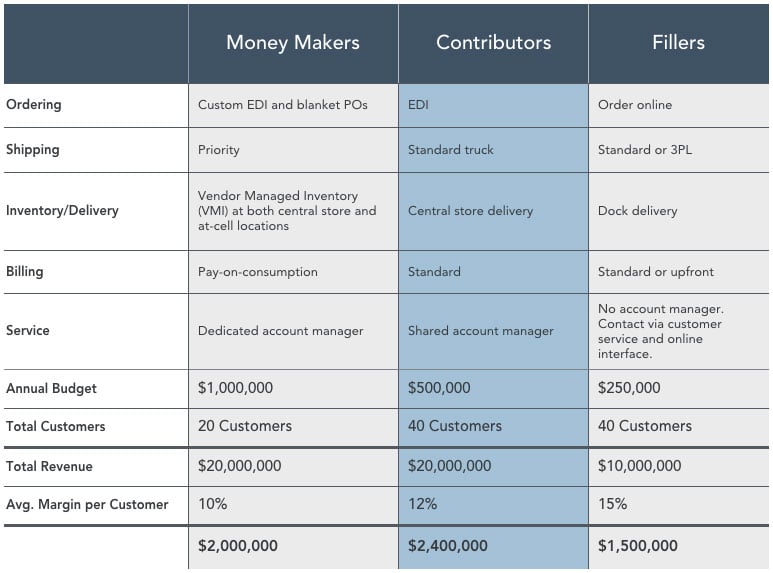


Let's face it: not all customers are created equally. Today, many industrial service and distribution companies are looking to optimize their base of customers and take a more strategic approach to upselling their standing opportunities. In general, they want better customers—in shape, size, and specialty—that fit what they do best.
In a previous article here on the Whole Brain Marketing Blog called, “Focus on Retention: The Cost of Not Delighting Customers,” we discussed the importance of categorizing the health of your customer relationships, assigning a health index to each, and managing that index effectively. Why? Retaining your customers is critical to fostering positive referrals, and, for most companies, customer retention is far less expensive than adding new business.
In today's article, we'll look at how to segment and identify your best customers relationships with the purposes of deploying marketing and sales to nurture and close more profitable deals among customers. This is a 3-step process, in which you'll (1) identify strong upsell targets, (2) explore expansion or upsell deals, and (3) execute a fully aligned marketing and sales plan to close these opportunities.
When seeking out business development among existing customers, it's crucial to understand which current customers fit your ideal targets and which customers aren't worth the time or frustration required to do business with them.
Generally, business development experts separate recurring customers into three broad categories—we'll call them "Money Makers," "Contributors," and "Fillers."
These customers have the largest budgets, take advantage of many business services, are profitable, and may require more account attention than is typical for other clients. While they require a lot of attention, thought, and resources, they appreciate the extensive services you can offer and are willing to compensate you for it.
Contributors have moderate budgets, use a specific set of products/services, and they can generally be characterized as profitable, predictable, and consistent. While not your top spenders, they score high on your customer health index and are extremely valuable to your business.
Average-to-low budgets with repeatable needs and are relatively self-serve. These customers fill in the gaps between larger customers and are a nice foundation to your business. Often, filler customers don't bring in recurring revenue and, instead, your work for them might be characterized as repeated project work.
After you’ve identified your categories, try to align your services to each and determine which customer type is the most profitable. Here's one example of how a distribution company could qualify their existing customer base:

Notice that your analysis should evaluate your service offering alongside the profitability of each group. You want to objectively understand which customer type is most profitable in the context of the service model you're offering.
In the supply chain example above, 20% of the customers are Money Makers, 40% are Contributors, 40% are Fillers.
With a business development mentality, your goal should be to provide services that are most likely to improve customer health and happiness, leading to referral and upsell opportunities. The graph showcases a scenario in which Contributors and Money Makers are the core revenue makers, while the company should focus on upgrading Filler customers into better categories or replace them with new business.
As you can see, the Contributors are actually the most profitable group, even though on an individual account level, managers would likely place more emphasis on the Money Makers' column—because they require more attention and timeliness and have larger budgets. (Hence, the characterization of such clients as "Money Makers" is more of a misnomer than anything.)
With this analysis of your customer base, you can quickly identify ways of upselling Fillers into the Contributors category, while restraining the number of Money Makers, so as to maximize margin.
Account managers often shy away from active upselling because they don't want to scare off the customer. But if you look at the difference between Fillers and Contributors in the graph above, you'll notice that difference in service is huge; Fillers are mostly self-service, while Contributors can be counted as real relationships. That means by becoming Contributors, Fillers will receive more help, guidance, and consultation.
In today's world, the best sales strategies focus on being as helpful and as consultative as possible. If your inherent goal in upselling is to provide more advice and better guidance, you'll find two things: (1) the sales process itself is much easier to manage, and (2) the content marketing you'll use to nurture customers' interest in bigger packages will seem more natural and authentic - see next section.
As you can tell from the analysis above, professional service and distribution companies rely on their sales and customer service teams to work together to generate upsell opportunities. The focus for both departments must be on remaining helpful to customers, and finding genuine opportunities where they can add value.
However, internal alignment should not stop there. Inbound marketing plays a huge role in cultivating a well-developed and loyal customer base. Every upsell opportunity—whether its repackaged offerings, new services, or a larger retainer size—can and should be thoroughly explained in a way that's attractive to customers. Check out these articles we've put together on marketing to customers for more detailed tactical plans:
If you aren't actively nurturing your existing clients through email marketing and social media, you're missing a big opportunity to keep them actively engaged.
As part of a holistic inbound marketing plan, you should nurture and improve multiple components of your customer base, and this means getting everybody in your organization on the same page, from account management to marketing to sales. See more about how we help grow better internal relationships with this video blog on service level agreements and marketing-to-sales alignment.
Topics: Marketing Automation, Inbound Sales
